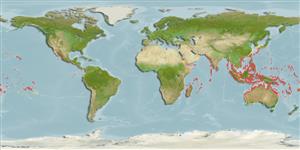Common names from other countries
Environment: milieu / climate zone / depth range / distribution range
Ekologi
. Tropical
Indo-Pacific: East Africa to eastern Polynesia; absent from Australia, apart from some oceanic coral reefs off northwest Australia.
Length at first maturity / Size / Weight / umur
Maturity: Lm ? range ? - ? cm Max length : 6.0 cm ShH jantan/; (Ref. 349); common length : 4.5 cm SHL jantan/; (Ref. 349)
Locally collected for food or for its shell (Ref. 349). Inhabits rather rough waters, under slabs and stones or in hollow corals near the wave swept edge. Active at night on algal crests and rock platforms. Also found in shallow subtidal zones (Ref. 349).
Life cycle and mating behavior
Kematangan | Reproduksi, perkembang biakan | Pemijahan | telur-telur | Fecundity | Larva
Members of the order Neotaenioglossa are mostly gonochoric and broadcast spawners. Life cycle: Embryos develop into planktonic trocophore larvae and later into juvenile veligers before becoming fully grown adults.
rujukan utama
Acuan | Koordinator | mitra
Poutiers, J.M. 1998. (Ref. 349)
Status IUCN Red List (Ref. 130435)
status CITES (Ref. 108899)
Not Evaluated
Not Evaluated
ancaman kepada manusia
Harmless
penggunaan manusia
| FishSource |
Alat, peralatan
Sumber internet
Estimates based on models
Preferred temperature
(Ref.
115969): 25.4 - 29.5, mean 28.3 (based on 476 cells).
keancaman
Low vulnerability (10 of 100).
kategori harga
Unknown.
